The Alphacool Eisbaer 240 CPU AIO Liquid Cooler Review
by E. Fylladitakis on August 1, 2016 9:00 AM EST- Posted in
- Cases/Cooling/PSUs
- AIO
- Water Cooling
- Cooler
- Alphacool
The Alphacool Eisbaer 240 CPU Liquid Cooler
Even though the radiator of the Eisbaer strongly resembles the radiators of many other AIO liquid coolers, the rest of the assembly is unique compared to any other that we have seen up to this date. To begin with, while the Eisbaer is upplied assembled and prefilled but it actually is a standard liquid cooling kit, as the tubing is not permanently attached on either the radiator or the block/pump assembly. Typical tubing compression fittings are used on both parts that can be undone at any time by the user.
The glossy black tubing of Eisbaer appears to be made out of PVC and has an internal diameter of 11 mm, which is much more than sufficient for a simple system with just one block. A black spring surrounds the glossy black tubing, preventing it from kinking when taking sharp turns. Alphacool also included a plastic connector on one of the tubes, offering the option of relatively quick future upgrades.
The radiator of the Eisbaer may be visually almost identical with the radiators used by many other products. A closer inspection however reveals a major difference: both the channels and the fins of this radiator are made out of copper. This makes the radiator a little heavier and considerably more expensive to manufacture, but it should also offer a noteworthy performance boost. The company logo can be seen printed on the sides of the steel frame.
Eisbaer’s block/pump assembly is quite tall but not very wide, with a plastic body and a copper base. There is a fill tap on the top of the assembly, allowing the user to refill and maintain the system. The company’s logo has LED lights installed and will illuminate blue once the pump is powered on. A little window on the side reveals the pump and fluid to the user. As this would not be visible from the side panel of the case, Alphacool did not install LEDs inside the block.
Inside the assembly we can see one of Alphacool’s pump designs based on the DC-LT Ceramic 12V pumps. The maximum flow is 70 L/h and it has a head of 0.85 m, figures that may not be great compared to those of large external pumps, yet are impressive for such a small device.
The copper base of the cooler is very smooth and appears to have been machined down to a perfect mirror finish. Unfortunately, copper is very easily oxidized and we received one of the pre-production samples that only had a temporary protective sticker attached. It was not attached well and the trapped air oxidized the base of our sample, creating an abstract canvas. This cannot and will not affect the performance of the cooler in any way, it is a mere aesthetic mishap that degrades the appearance of the product.


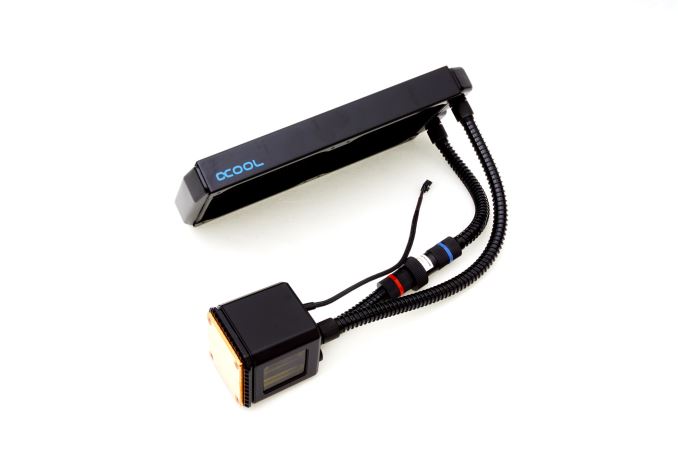
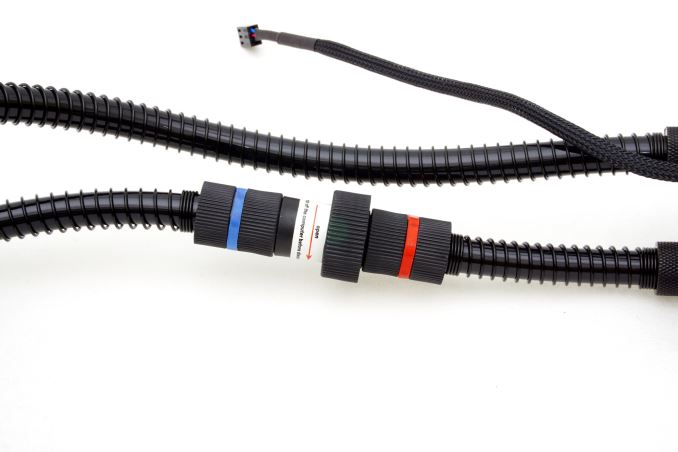
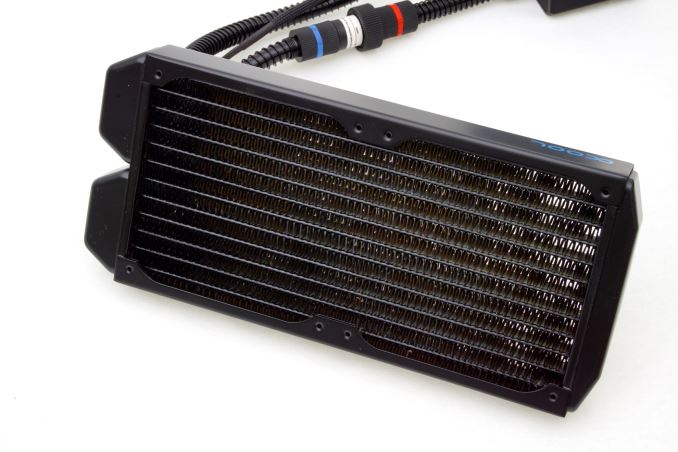
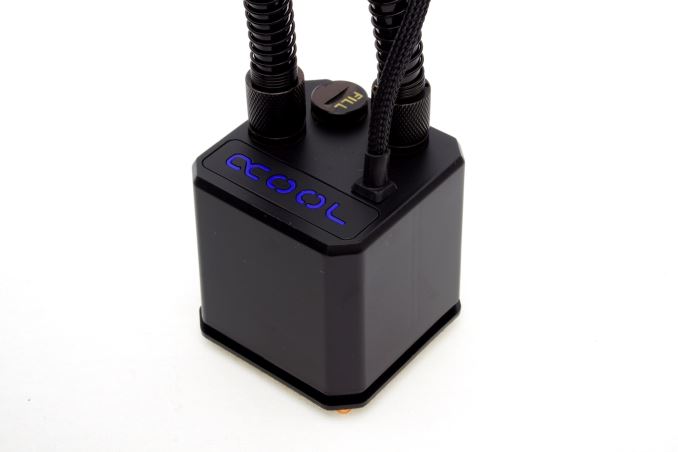
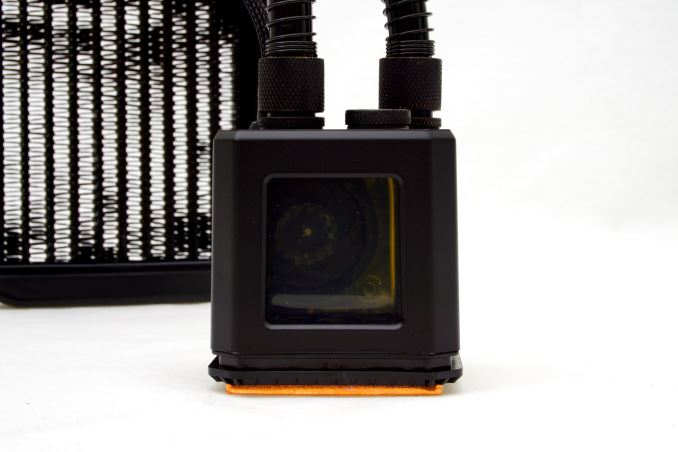









69 Comments
View All Comments
ikjadoon - Tuesday, August 2, 2016 - link
You're behind. :( Already a 120mm rad with 2 fans is both 5C cooler and 0.1dB quieter than your Noctua NH-U14S.http://www.hardocp.com/article/2016/02/11/arctic_c...
FWIW, I also have a NH-U14S. Noctua buddies! :D
ikjadoon - Tuesday, August 2, 2016 - link
Nope. You are stuck in 2014. :( Gen5 Asetek is very good.5C cooler than the NH-U14S and 0.1db quieter. Maybe has other flaws...but it's not noise!
ikjadoon - Tuesday, August 2, 2016 - link
Forgot the damn link:http://www.hardocp.com/article/2016/02/11/arctic_c...
ikjadoon - Monday, August 1, 2016 - link
LOL. Using water-cooling on a CPU? You all gobbled up the marketing; you still believe in in 1990s ATX case design.GPUs need the water, not the CPU. 250W+ on load, using 9cm fans? Average load temps in the 70s with overclocking and overvoltage? Right, yes, put the water cooler on the CPU. :p
Abandon ATX cooling assumptions; it was meant for cooling Pentium 4's and 3.5" spindle disks.
wylie102 - Monday, August 29, 2016 - link
From what I've read you are right about this. My question would be - given that air CPU coolers vent/radiate their hot air into the case, as do graphics cards (open air designs at least) would it not be beneficial to have an AIO liquid cooler drawing in air from the case (it being warm shouldn't affect the CPU cooling too much as like you said, most units are more than capable) and venting it out of the case?Would this not provide a benefit to the temp of the case and therefore the cooling abilities of the graphics card (particularly if running SLI)? And doesn't it make sense to have the CPU do this given that cooling options are much more widely available for them and at less of a premium than GPU water cooling?
Hxx - Monday, August 1, 2016 - link
AIO coolers are still very much needed these days especially in a smaller form factor where air flow is not as great as in a larger case. I personally think that air coolers have reached their EOL. There is no need for a big chunk of metal to sit on top of your motherboard especially when nowadays you can buy an excellent AIO that is reasonably priced, quiet, cools better, and looks aesthetically more pleasing, and its painless to install.there used to be a time when AIOs used to be so much more money, kind of like how it is now if you want to jump into a custom loop. There is a price to performance ratio that needs to be addressed. But as far as closed loops, some of them are almost just as inexpensive as an air cooler and providing much more benefits.
retrospooty - Monday, August 1, 2016 - link
I dont think so... When talking about building a new system, we are talking Intel Skylake CPU. Anything running a Skylake is already cool as hell. There are some great small form factor cases and premade systems, as small as Lenovo Tiny Desktop that are running quad core i5 and i7 desktop processors. They are a little over 1 inch thick and dont even get hot. You would only need it if you had both a really thin/small case AND you were significantly overclocking it... Now if you bought a good enough motherboard to significantly overclock it, what case are you getting that is too small to fit a decent air cooler, but big enough where it can still fit a decent power supply that can handle significant overclocking and even a small AIO water cooler? Where is the radiator in this setup? Is it outside the case?ikjadoon - Tuesday, August 2, 2016 - link
...there are strong ITX overclocking motherboards. You don't need 1kW to OC; even SFX PSUs are in the 700W range, more than enough for dual-GPU OC + 8-core CPU OC.retrospooty - Tuesday, August 2, 2016 - link
I get that, but still what is the point? If you are overclokcing to that level, you probably arent using a tiny case. If you are, that fine, but again I ask - Where is the radiator in this setup? Is it outside the case?Sushisamurai - Sunday, August 7, 2016 - link
I'm running a tri-fire and 6core CPU. I should have a custom loop on the GPU's, but... whatever, they're too old now to drop that much money into them. Full load is close to 1000W - it's potentially a lot of heat, but radiator's are in the case, with a lot of airflow. GPU's hit 80 degrees and CPU's @60.